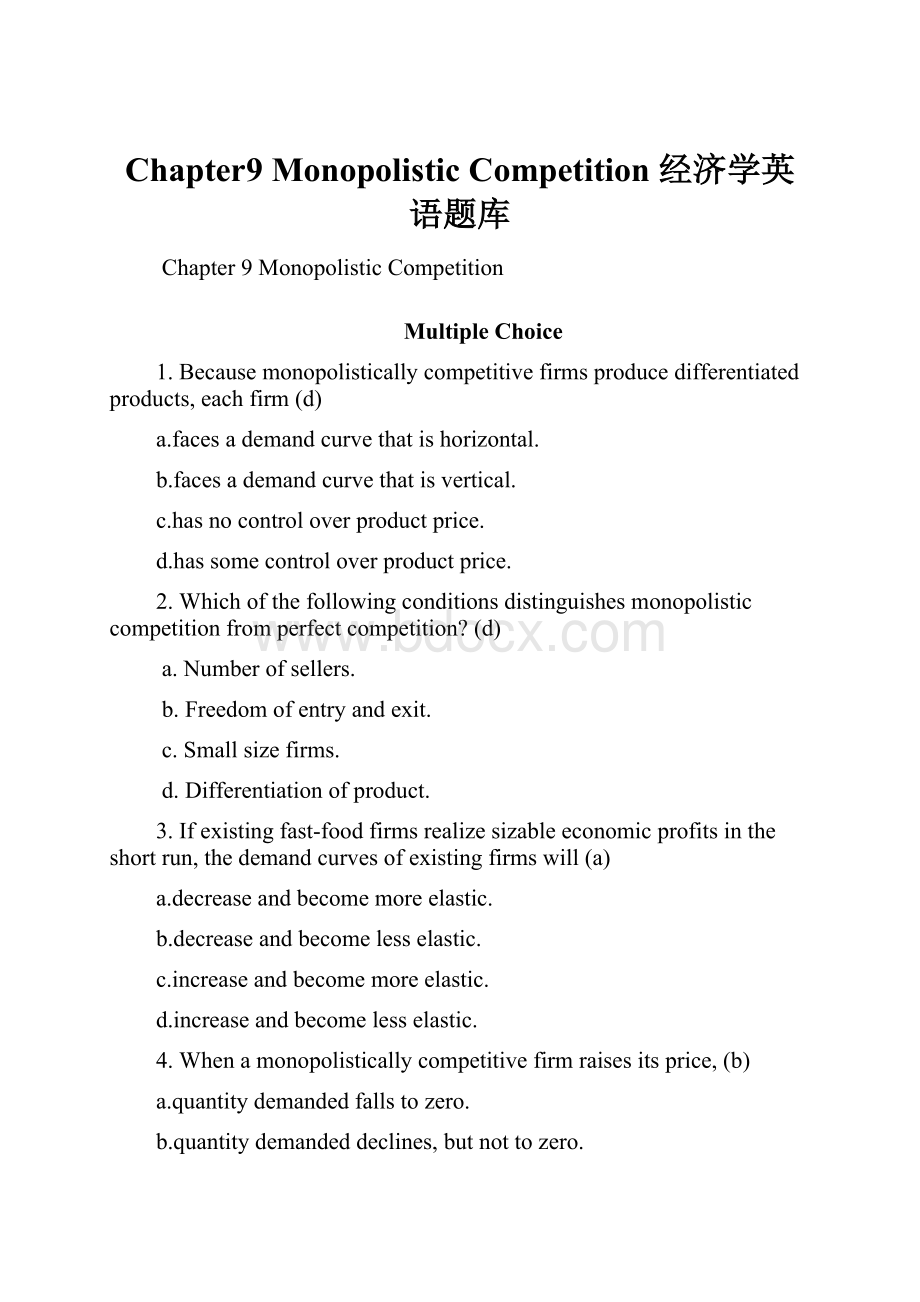Chapter9 Monopolistic Competition经济学英语题库.docx
《Chapter9 Monopolistic Competition经济学英语题库.docx》由会员分享,可在线阅读,更多相关《Chapter9 Monopolistic Competition经济学英语题库.docx(15页珍藏版)》请在冰豆网上搜索。

Chapter9MonopolisticCompetition经济学英语题库
Chapter9MonopolisticCompetition
MultipleChoice
1.Becausemonopolisticallycompetitivefirmsproducedifferentiatedproducts,eachfirm(d)
a.facesademandcurvethatishorizontal.
b.facesademandcurvethatisvertical.
c.hasnocontroloverproductprice.
d.hassomecontroloverproductprice.
2.Whichofthefollowingconditionsdistinguishesmonopolisticcompetitionfromperfectcompetition?
(d)
a.Numberofsellers.
b.Freedomofentryandexit.
c.Smallsizefirms.
d.Differentiationofproduct.
3.Ifexistingfast-foodfirmsrealizesizableeconomicprofitsintheshortrun,thedemandcurvesofexistingfirmswill(a)
a.decreaseandbecomemoreelastic.
b.decreaseandbecomelesselastic.
c.increaseandbecomemoreelastic.
d.increaseandbecomelesselastic.
4.Whenamonopolisticallycompetitivefirmraisesitsprice,(b)
a.quantitydemandedfallstozero.
b.quantitydemandeddeclines,butnottozero.
c.themarketsupplycurveshiftsoutward.
d.quantitydemandedremainsconstant.
5.Thereareseveralreasonswhydemandcurvesmaybecomemoreelastic.Amongthemare(b)
a.themarketbecomesmoremonopolisticandcrosselasticitiesapproachzero.
b.thegoodsbecomelessdifferentiatedandmorefirmsentertheindustry.
c.consumershavefewersubstitutesandfirmsdropoutoftheindustry.
d.industrydemandincreasesandconsumersincreasespending.
6.Whichofthefollowingisacharacteristicofoligopolyormonopolisticcompetition,butnotperfectcompetition?
(a)
a.Advertisingandsalespromotion.
b.ProfitmaximizationaccordingtotheMR=MCrule.
c.Firmsbeingpricetakersratherthanpricemakers.
d.Horizontaldemandandmarginalrevenuecurves.
7.Productdifferentiationallowsthefirmto(b)
a.raisepriceandlowerquantitydemanded.
b.raisepricewithoutsufferingasubstantiallossofsales.
c.shiftthemarketdemandcurvetotheleft.
d.decreasebarrierstoentry.
8.Themaximumtotalshortruneconomicprofit,orminimumloss,forthemonopolisticallycompetitivefirminthisfigureis©
a.zero.
b.aprofitof$575.00.
c.aprofitof$2,000.00.
d.alossof$375.00.
9.Cecilia’sCaféisamonopolisticcompetitor.IfCecilia’siscurrentlyproducingattheoutputlevelwhereheraveragetotalcostisminimizedandthecaféisearningeconomicprofits,theninthelongrunoutputwill(a)
a.decreaseandaveragetotalcostwillincrease.
b.decreaseandaveragetotalcostwilldecrease.
c.remainunchangedasCecilia’sisdoingthebestitcan.
d.increaseandaveragetotalcostswilldecrease.
10.Inthelongrun,freedomofentryintoamarketforcesa(b)tochargeapriceequaltoaveragetotalcost,butaveragetotalcostexceedsitsminimumlevel
a.perfectlycompetitivefirm
b.monopolisticallycompetitivefirm
c.oligopolisticfirm
d.puremonopoly
11.Whichofthefollowingbestdescribestheideaofexcesscapacityinmonopolisticcompetition?
(b)
a.Firmsproducemoreoutputthanissociallydesirable.
b.Theoutputproducedbyatypicalfirmislessthanwhatwouldoccuratthe
minimumpointonitsATCcurve.
c.duetoproductdifferentiation,firmschooseoutputlevelswhereP>ATC.
d.firmskeepsomesurplusoutputonhandincasethereisashiftinthedemand
fortheirproduct.
12.Whichofthefollowingindividualsquotedbelowisleastlikelytoarguethatexcesscapacityinmonopolisticallycompetitiveindustriesisawasteofresources?
(b)
a.“Anautomobileistransportation,nothingelse.”
b.“Tomatoesornotomatoes.Thechoiceoftoppingsonaburgercanbe
importanttoaconsumerthesedayswhenindividualismisincreasinglyimportanttopeople.”
c.“Gasolineisgasolinenomatterwhatthebrandname.”
d.“ItaketheairlinethatwillgetmefromAtoBatthelowestprice.”
13.Thetraditionalviewofmonopolisticcompetitionholdsthatthistypeofindustrialstructureisinefficientbecause(b)
a.therearetoofewfirmstoreachanefficientlevelofproduction.
b.firmsdonotoperateattheoutputthatminimizesaveragecosts.
c.advertisingisnotusedextensivelyenoughtoyieldanefficientdifferentiation
oftheproducts.
d.consumersdonothaveenoughchoiceamongtheproductvarietiesavailable.
14.Monopolisticcompetitionisconsideredbysometobeinefficientbecause(a)
a.priceexceedsmarginalcost.
b.outputexceedscapacityoutput.
c.longrunprofitsarepositive.
d.ofalloftheabove.
15.Perhapsit’snotaproblematall,butif“toomuchchoice”isaproblemforconsumers,itwouldoccurinwhichmarketstructure(s)?
(c)
a.Perfectcompetition.
b.Monopoly.
c.Monopolisticcompetition.
d.Perfectcompetitionandmonopolisticcompetition.
16.Whichofthefollowingmightbeaneffectofadvertising?
(d)
a.Increasedproductdifferentiation.
b.Increasedtotalcostsofproduction.
c.Increaseddemandfortheproduct.
d.Alloftheabove.
17.Inthelongrunundermonopolisticcompetition,whenfirmsadvertise,(a)
a.theywillstillearnzeroeconomicprofit.
b.theycanearnpositiveeconomicprofitbyincreasingmarketshare.
c.themarketpricemustfall.
d.themarketpricemustrise.
18.Advertising(d)
a.providesinformationaboutproducts,includingpricesandsellerlocations.
b.hasbeenproventoincreasecompetitionandreducepricescomparedto
marketswithoutadvertising.
c.signalsqualitytoconsumers,sincefirmsspendsomuchmoneyonads.
d.doesalloftheabove.
29.Criticsofadvertisingarguethat(a)
a.advertisingwastesresourcesbecauseitcreatesanimagewithoutnecessarily
improvingproductquality.
b.advertisinglowersbarrierstoentryintoanindustrybecausenewfirmscanmoreeasilyestablishthemselvesascompetitors.
c.advertisingincreasescompetitionbyprovidinginformationaboutprices.
d.advertisingencouragesmonopolizationofmarketsbyraisingentrybarrierstoo
high.
30.Manyairlinespromise“frequentflyer”milestopassengerswhoflytheirairlinesregularly.Thisisanexampleofafirmattemptingtocreate(d)
a.pricediscrimination.
b.apredatorypricingscheme.
c.discountingbelowmarginalcosts.
d.brandloyalty.
31.OneofthereasonsthatKodakandFujifilmsadvertisesomuchisthat(c)
a.eachhopestocreateanaturalmonopoly.
b.theyareinaperfectlycompetitiveindustrywhereadvertisingisthedifference
betweeneconomicandnormalprofits.
c.theywanttodevelopbrandloyalty.
d.theywanttoincreasepriceelasticitiesofdemand.
32.IfsomecoffeedrinkerscontinuetobuyMaxwellHousecoffeeevenwhenFolger’scoffeeisonsaleandcheaper,itmaybearesultof(c)
a.irrationalconsumerbehavior.
b.ahighcrosselasticitybetweenthetwogoods.
c.brandloyalty.
d.MaxwellHousebeingamonopoly.
ShortAnswerAndEssay
1.Howdothecharacteristicsofperfectcompetitionandmonopolisticcompetitiondiffer?
Answer:
Inmonopolisticcompetition,theproductssoldaresimilarbutdifferentiated,therebyenablingfirmstocompeteonthebasisofproductdevelopmentandmarketingtofurtherdifferentiatetheirproducts.Inperfectcompetitiontheproductsareidentical,therebyeliminatingtheopportunityforfirmstocompetebydifferentiatingtheirproduct.
2.Whyiscollusionaboutthepriceandamountofoutputimpossibleinmonopolisticcompetition?
Answer:
Thesmallerthenumberoffirms,themorelikelycollusionistooccur.Monopolisticcompetitionhastoomanyfirmsforcollusiontobesuccessful.
3.Whatdodemandandmarginalrevenuecurveslooklikeinmonopolisticcompetition?
Howdotheycomparetothedemandandmarginalrevenuecurvesinperfectcompetitionandmonopoly?
Answer:
Inmonopolisticcompetition,theproductisdifferentiated.Thisfactgiveseachfirmsomecontroloverprice,soeachfirm’sdemandcurveisdownwardsloping.Becausetherearemanyclosesubstitutesforthesefirms’goods,demandiselastic.Thesefirmsmustlowertheirpricetosellmore;thereforethemarginalrevenuecurveisbeneaththedemandcurve.
Inperfectcompetition,theproductishomogeneous,whichmakesfirmsprice-takers,abletosellasmuchastheywishatthemarketprice.Therefore,marginalrevenueequalsprice,andthemarginalrevenuecurveandthedemandcurvearethesameandarehorizontal.
Inmonopoly,thereisonlyonefirm.Thefirmfacesthemarketdemand,whichissteep,becausetherearenoclosesubstitutesforthegood.Thefirmmustloweritspricetosellmore,soforasingle-pricemonopoly,themarginalrevenuecurveisbeneaththedemandcurve.
4.WhatistheHerfindahl-HirschmanIndexandwhatdoesitmeasure?
Answer:
TheHerfindahl-HirschmanIndex,orHHI,isanindexusedtomeasuretheextenttowhichamarketisdominatedbyasmallnumberoffirms.TheHHIequalsthesumofthesquaredpercentagemarketsharesofeachofthe50largestfirmsinthemarket.AmonopolywillhaveaHHIof10,000whereasperfectcompetitionwillhaveasmallHHI.
5.“Afirminmonopolisticcompetitionmaximizesitsprofitbyproducingwhereitspriceisequaltoitsmarginalcost.”Isthepreviousstatementcorrectorincorrect?
Answer:
Thestatementisincorrect.Afirminmonopolisticcompetitionmaximizesitsprofitbyproducingwhereitsmarginalrevenueequalsitsmarginalcost.Becausethemarginalrevenueislessthanthepriceforafirminmonopolisticcompetition,itdefinitelyisnotthecasethatthefirmproduceswhereitspriceequalsitsmarginalcost!
6.Howdoesafirminmonopolisticcompetitiondetermineitspriceandquantity?
Whattypeofprofitcanitearnintheshortrunandthelongrun?
Answer:
Thefirmproduceswhereitsmarginalcostequalsitsma